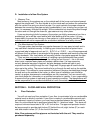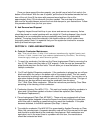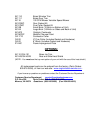
3. Place several wads of crushed newspaper over the entire bottom of the firebox.
4. Lay small dry sticks of kindling on top of the paper.
5. Ignite the paper. Leave the door cracked until the kindling is burning freely --
approximately ten to fifteen (10 to 15) minutes.
6. Once you have established a hot bed of coals, open the door and add a few pieces
of dry split wood. Leave the door cracked and allow the unit to burn for approximately
thirty (30) minutes. After this time, more split wood can be added.
7. The final step is to close the by-pass damper and place the slide damper (located
under the ash apron) to your desired setting.
Note: Pulling the slide damper out will
increase the amount of combustion air and allow a faster burn.
NOTE: It is very important the above procedure be followed to ensure the catalytic
combustor reaches the proper temperature. It is recommended the combustor be
operated at 700 to 1400 degrees Fahrenheit; the combustor must be 500 degrees
Fahrenheit or above before it will accept the smoke fumes. Operating the unit above
1800 degrees will damage the combustor, although temperatures between 1400 and
1600 degrees are common. If minor-build up is evident on the combustor, run the unit at
a high rate and leave the by-pass damper partially open to help clean the combustor. A
one fourth inch (¼”) button plug is located on the top left side of the stove. This plug can
be removed and a Condor probe thermometer (Part #AC-13) inserted, which will display
the actual temperature of the combustor. This part can be ordered by your local dealer
or from the factory.
B. Draft Control
This unit has a slide draft control located under the ash apron, which is used to
regulate the amount of combustion air. This controls the amount of heat the stove
produces, as well as the burn time. The more you open the draft by pulling out the
handle, the more combustion air enters the firebox; this will cause the stove to burn
hotter and faster. You will have to experiment with your unit for the most efficient setting,
as no two chimneys are the same. If you have problems regulating the unit please call
your dealer or the factory.
C. Do Not Over-Fire Your Stove
Burning flammable liquids, too much wood and trash in the stove can result in over-
firing. If the chimney pipe turns red or even worse, white, the unit has been over-fired.
This may ignite creosote in the chimney and possibly cause a house fire. If this does
happen, immediately close the slide damper by pushing it in completely and close the
by-pass damper. Get out of the house and call the fire department. A chimney fire may
cause structural damage to the chimney system, therefore do not use the stove until the
entire flue system is inspected and, if necessary, repaired or replaced. A chimney sweep
can perform this inspection.
D. Everyday Fueling
This unit is designed to burn eight to ten (8 to 10) hours on one load of firewood.
Always open or pull out the by-pass damper before opening the stove door.
The door
should be cracked for five to ten (5 to 10) minutes to allow the excess smoke to clear
through your flue system.















